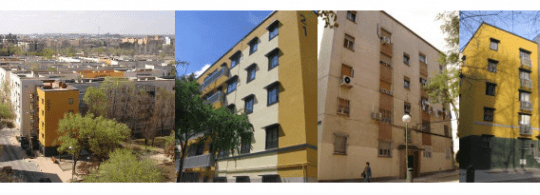
Last September, the Infrastructure and Urban Development Committee of the Spanish Confederation of Employers’ Organizations (CEOE) and Spain’s National Construction Federation (CNC) published a report entitled “La rehabilitación de edificios como motor de crecimiento y empleo” “), which analyses the effects on employment of a long-term strategy of investing in the refurbishment of the country’s buildings, as suggested by EU Directive 2012/27 on Energy Efficiency.
The document presents a series of scenarios that underline the effects that investment in energy efficient refurbishment of buildings would have on the economy, employment, and compliance with targets for emission reduction and energy efficiency. It also sets out a series of measures, approved by the sector, to promote the construction industry through building refurbishment. They are organised into three categories:
- Regulatory and administrative measures to facilitate rehabilitation and energy efficiency upgrading of buildings.
- Funding and project execution measures.
- Information and communication measures, which support building refurbishment and energy efficiency.

According to the report, the refurbishment industry will not develop if the latter two sets of measures are not implemented. Accordingly, a funding model must be implemented that, from the outset, provides direct government subsidies together with subsidised credit lines and low-interest loans, the goal being to transition gradually from subsidies to loans.

It’s also necessary to execute a campaign to raise awareness among citizens about the importance of implementing energy efficiency measures and improving residential buildings to achieve energy savings, by detailing the advantages of refurbishment with energy efficiency criteria and underlining the legal obligations with respect to preserving and maintaining buildings. The document suggests raising awareness about the improvements in well-being, health and comfort to be achieved by people living in refurbished buildings and the rise in value of such property and of urban areas. The report also underlines some surprising figures: there are 920,000 residential buildings in Spain that are dilapidated or in a poor state of repair. There are also 2,268,000 buildings in a good state of repair, but which require a Building Evaluation Report. Moreover, there are 5,412,000 homes having two or more above-ground floors that pose accessibility problems. Just 4.59% of existing homes were built in accordance with the 2007 Building Code and 39.1% with the 1979 code, while 56.31% were not built in line with any minimum energy savings regulation. As a result, there are 9,287,505 buildings (of 9,730,999 in total) which do not meet basic energy saving requirements, unless they have been upgraded recently.
The building industry must reinvent itself to meet the population’s housing needs and focus on ensuring quality housing and resolving shortfalls in connection with accessibility, safe usage, and adaptability to accommodate an increasingly older population. The objective is to develop a new environmentally and economically sound industry that deals basically with refurbishing existing homes.
Sources:
- Portal construible.es
- Página web de la Confederación Española de Organizaciones Empresariales: ceoe.es
- Informe: “La rehabilitación de edificios como motor de crecimiento y empleo”, Comisión de Infraestructuras y Urbanismo, CEOE, Septiembre 2014.





There are no comments yet